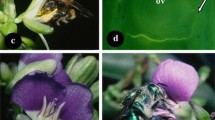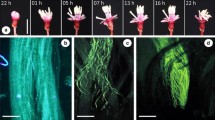Abstract
Multi-cycle synchronous dichogamy is expected to be a mechanism for reducing self-pollination and sexual interference. It is often found in plants with umbellate inflorescences where pollinator movement is unpredictable, but not in plants with raceme inflorescences that are pollinated by bumblebees. Plants with raceme inflorescences often acropetally open flowers, resulting in an arrangement of females at lower level and males at upper level. This is good enough to preclude geitonogamy because bees tend to move upwardly within the inflorescences. Furthermore, although the degree of segregation of sexes varies among species, their intraspecific variations within a population have rarely been examined. Here, we present a synchronous protandry in bee-pollinated Aconitum grossedentatum, which has a raceme-like inflorescence and opens flowers basipetally. To evaluate the functional significance of synchronous dichogamy in mating, we firstly observed the distribution of sex phases of open flowers. Then, we assessed the effect of each phase flower on foraging behavior by pollinators and seed-set success. The inflorescences tended to exhibit either male- or female-phase flowers at any moment early in the flowering season, but the degree of segregation of sexes declined over time within a population. The degree of the segregation did not affect bumblebee visits to flowers, but it decreased seed-set success of female-phase flowers at that time. Our results demonstrated that synchronous protandry was beneficial for pollination success in A. grossedentatum by avoiding geitonogamy. Nevertheless, we also found asynchronous protandry late in the season, suggesting that the benefits by synchronous protandry decreased over the season.




Similar content being viewed by others
References
Aizen MA, Basilio A (1995) Within and among flower sex-phase distribution in Alstroemeria aurea (Alstroemeriaceae). Can J Bot 73:1986–1994
Ashman TL, Schoen DJ (1994) How long should flowers live? Nature 371:788–791
Ashman TL, Schoen DJ (1996) Floral longevity: fitness consequences and resource costs. In: Lloyd DG, Barrett SCH (eds) Floral biology: studies on floral evolution in animal-pollinated plants. Chapman and Hall, New York, pp 140-190
Barrett SCH, Harder LD (2017) The ecology of mating and its evolutionary consequences in seed plants. Annu Rev Ecol Evol Syst 48:135–157
Bertin RI (1993) Incidence of monoecy and dichogamy in relation to self-fertilization in angiosperms. Am J Bot 80:557–583
Bertin RI, Newman CM (1993) Dichogamy in the angiosperms. Bot Rev 59:112–152
Bhardwaj M, Eckert CG (2001) Functional analysis of synchronous dichogamy in flowering rush, Butomus umbellatus (Butomaceae). Am J Bot 88:2204–2213
Brunet J, Charlesworth D (1995) Floral sex allocation in sequentially blooming plants. Evolution 49:70–79
Brunet J, Eckert CG (1998) Effect of floral morphology and dis- play on outcrossing in blue columbine, Aquilegia caerulea (Ranunculaceae). Func Ecol 12:596–606
Eckert CG (2000) Contributions of autogamy and geitonogamy to self-fertilization in a mass-flowering, clonal plant. Ecology 81:532–542
Gao J, Xiong YZ, Huang SQ (2015) Effects of floral sexual investment and dichogamy on floral longevity. J Plant Ecol 8:116–121
Handel SN (1985) The intrusion of clonal growth patterns on plant breeding systems. Am Nat 125:367–383
Harder LD, Aizen MA (2004) The functional significance of synchronous protandry in Alstroemeria aurea. Func Ecol 18:467–474
Harder LD, Barrett SCH (1996) Pollen dispersal and mating patterns in animal pollinated plants. In: Lloyd DG, Barrett SCH (eds) Floral biology: studies on floral evolution in animal-pollinated plants. Chapman and Hall, New York, pp 140–190
Harder LD, Thomson JD (1989) Evolutionary options for maximizing pollen dispersal of animal-pollinated plants. Am Nat 133:323–344
Harder LD, Wilson WG (1994) Floral evolution and male reproductive success: optimal dispensing schedules for pollen dispersal by animal-pollinated plants. Evol Ecol 8:542–559
Harder LD, Jordan CY, Gross WE, Routley MB (2004) Beyond floricentrism: the pollination function of inflorescences. Plant Spec Biol 19:137–148
Harder LD, Richards SA, Routley MB (2008) Effects of reproductive compensation, gamete discounting and reproductive assurance on mating-system diversity in hermaphrodites. Evolution 62:157–172
Holtsford TP, Ellstrand NC (1992) Genetic and environmental variation in floral traits affecting outcrossing rate in Clarkia tembloriensis (Onagraceae). Evolution 46:216–225
Hu Y, Barrett SCH, Zhang D-Y, Liao W-J (2015) Experimental analysis of mating patterns in a clonal plant reveals contrasting modes of self-pollination. Ecol Evol 5:5423–5431
Ishii HS, Harder LD (2012) Phenological associations of gender with floral morphology and integration in protandrous Delphinium glaucum. J Ecol 100:1029–1038
Kenward MG, Roger JH (1997) Small sample inference for fixed effects from restricted maximum likelihood. Biometrics 53:983–997
Kudo G, Maeda T, Narita K (2001) Variation in floral sex allocation and reproductive success within inflorescences of Corydalis ambigua (Fumariaceae): pollination efficiency or resource limitation? J Ecol 89:48–56
Lankinen Å, Madjidian JA (2011) Enhancing pollen competition by delaying stigma receptivity: pollen deposition schedules affect siring ability, paternal diversity and seed production in Collinsia heterophylla (Plantaginaceae). Am J Bot 98:1191–1200
Lee TD (1988) Patterns of fruit and seed production. In: Lovett-Doust J, Lovett-Doust L (eds) Plant reproductive ecology: patterns and strategies. Oxford University Press, New York
Liao W-J, Harder LD (2014) Consequences of multiple inflorescences and clonality for pollinator behaviour and plant mating. Am Nat 184:580–592
Lloyd DG, Webb CJ (1986) The avoidance of interference between the presentation of pollen and stigmas in angiosperms. I Dichogamy. N Z J Bot 24:135–162
Milliken GA, Johnson DH (1984) Analysis of messy data. Volume I: designed experiments. Van Nostrand Reinhold, New York
Morgan M (1993) Fruit to flower ratios and trade-offs in size and number. Evol Ecol 7:219–232
Norbona E, Ortiz PL, Arista M (2011) Linking self-incompatibility, dichogamy, and flowering synchrony in two Euphorbia species: alternative mechanisms for avoiding self-fertilization? PLoS ONE 6:e20668
Pellmyr O (1987) Multiple sex expressions in Cimicifuga simplex: Dichogamy destabilizes hermaphroditism. Biol J Linn Soc 31:161–174
Routley MB, Bertin RI, Husband BC (2004) Correlated evolution of dichogamy and self-incompatibility: a phylogenetic perspective. Int J Plant Sci 165:983–993
Snow AA, Spira TP, Simpson R, Klips RA (1996) The ecology of geitonogamous pollination. In: Lloyd DG, Barrett SCH (eds) Floral biology: studies on floral evolution in animal-pollinated plants. Chapman and Hall, New York, pp 191–216
Stephenson AG (1981) Flower and fruit abortion: proximate cause and ultimate functions. Annu Rev Ecol Syst 12:253–279
Stroup WW (2013) Generalized linear mixed models: modern concepts, methods and applications. CRC Press, Boca Raton
Thomson JD, Barrett SCH (1981) Temporal variation in Aralia hispida Vent. (Araliaceae). Evolution 35:1094–1107
Vallejo-Marín M, Dorken ME, Barret SCH (2010) The ecological and evolutionary consequences of clonality for plant mating. Annu Rev Ecol Evol Syst 41:193–213
Acknowledgements
We thank Miharu Kato for field assistance and Gaku Kudo and Lawrence D. Harder for constructive comments on an early version of the manuscript. We also appreciate two anonymous referees and an editor for providing constructive comments on the manuscript. Research funding was provided by JSPS KAKENHI Grant Number 19K06854 to TYI.
Author information
Authors and Affiliations
Corresponding author
Ethics declarations
Conflict of interest
No potential conflict of interest was reported by the authors.
Additional information
Communicated by Siegy Krauss.
Publisher's Note
Springer Nature remains neutral with regard to jurisdictional claims in published maps and institutional affiliations.
Electronic supplementary material
Below is the link to the electronic supplementary material.
Rights and permissions
About this article
Cite this article
Ida, T.Y., Minato, E. Multi-cycle synchronous protandry in raceme-like inflorescences of a bumblebee-pollinated herb Aconitum grossedentatum. Plant Ecol 221, 965–978 (2020). https://doi.org/10.1007/s11258-020-01054-9
Received:
Accepted:
Published:
Issue Date:
DOI: https://doi.org/10.1007/s11258-020-01054-9




